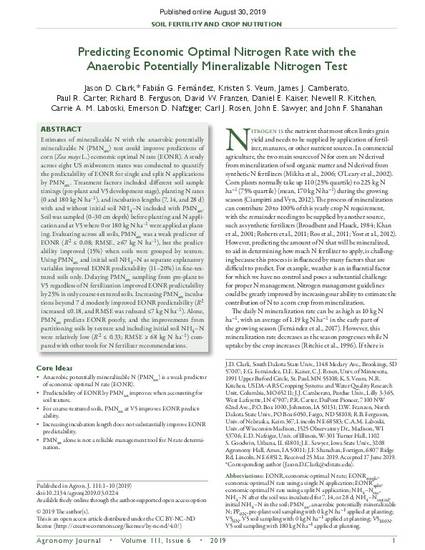
Estimates of mineralizable N with the anaerobic potentially mineralizable N (PMNan) test could improve predictions of corn (Zea mays L.) economic optimal N rate (EONR). A study across eight US midwestern states was conducted to quantify the predictability of EONR for single and split N applications by PMNan. Treatment factors included different soil sample timings (pre-plant and V5 development stage), planting N rates (0 and 180 kg N ha−1), and incubation lengths (7, 14, and 28 d) with and without initial soil NH4–N included with PMNan. Soil was sampled (0–30 cm depth) before planting and N application and at V5 where 0 or 180 kg N ha−1 were applied at planting. Evaluating across all soils, PMNan was a weak predictor of EONR (R2 ≤ 0.08; RMSE, ≥67 kg N ha−1), but the predictability improved (15%) when soils were grouped by texture. Using PMNan and initial soil NH4–N as separate explanatory variables improved EONR predictability (11–20%) in fine-textured soils only. Delaying PMNan sampling from pre-plant to V5 regardless of N fertilization improved EONR predictability by 25% in only coarse-textured soils. Increasing PMNan incubations beyond 7 d modestly improved EONR predictability (R2 increased ≤0.18, and RMSE was reduced ≤7 kg N ha−1). Alone, PMNan predicts EONR poorly, and the improvements from partitioning soils by texture and including initial soil NH4–N were relatively low (R2 ≤ 0.33; RMSE ≥ 68 kg N ha−1) compared with other tools for N fertilizer recommendations.
Available at: http://works.bepress.com/john-sawyer/428/

This article is published as Clark, Jason D., Fabián G. Fernández, Kristen S. Veum, James J. Camberato, Paul R. Carter, Richard B. Ferguson, David W. Franzen et al. "Predicting Economic Optimal Nitrogen Rate with the Anaerobic Potentially Mineralizable Nitrogen Test." Agronomy Journal 111 (2019): 1-10. doi: 10.2134/agronj2019.03.0224